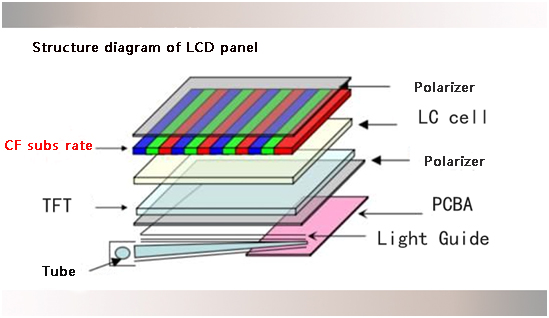LCD display technology -Introduction to CF substrate
Date:2023-08-23
The CF substrate of the TFT LCD is a key material for realizing TFT LCD
color display, which occupies the highest cost in the display screen. In
addition to affecting the color, the CF substrate also affects the optical
characteristics of TFT LCD's brightness and contrast. Below we briefly introduce
the material composition and product characteristics of the CF substrate.
1. The composition structure of the CF substrate
The main materials of the CF substrates include glass substrate, black
matrix BM, color layer RGB, protective layer OC, ITO conductive film, column
-shaped Spacer, etc. Different display modes, the composition structure of the
CF substrate will be slightly different.
1. Black matrix BM: Basic function is to shake light, improve the
contrast,avoid connected color layer mixing, reduce external light reflection,
and prevent external light from irradiating the A-SI layer to increase the
leakage current. Using BM can effectively cover the light leakage between the
pixels. To obtain a good shielding effect, it must be high -shading
concentration. The shading concentration is represented by OD value. The larger
the OD value, the better, which generally requires above 3.0. The resin BM is
basically used in the project, because the cost of resin BM is low and the
reflectance is low, and the phenomenon of reflex light or redness will not
occur. In addition to increasing the contrast of TFT LCD, in addition to
increasing the OD value of BM, it is necessary to strengthen the size accuracy
management to prevent leakage caused by the bonding deviation.
2. RGB color layer material: Most of the TFT LCD uses pixel segmentation
method to achieve color display, and the CF substrate forms RGB triple color
light. From the front of the CF substrate, the RGB color layer arranges can be
divided into strip arrangement, dot -shaped arrangement, triangular arrangement,
mosaic arrangement. Bar-shaped and dotted arrangements are generally used for
large -sized, high -fine TFT LCD products. Triangular and mosaic arrangements
are generally used for small -sized, low -precision TFT LCD products. The color
and transmission are the two optical characteristics of the CF substrate, mainly
depending on the RGB color layer material.
3. Protective layer OC, ITO conductive membrane, cylindrical spacer : The
role of the OC layer is to protect the RGB color layer while achieving the flat
surface of the CF surface. For the TN display mode and VA display mode, because
the RGB color layer will have ITO facial electrode coverage protection, it may
not require OC layer. IPS display mode does not have ITO facial electrode
coverage protection, and the OC protective layer is required. ITO conductive
film is a transparent film for conductive electricity. Because it is on the path
of light, its light transmitted rate must be high. The cylindrical spacer spacer
is to maintain cell gap uniformity , and the main component is UV hardening
acrylic resin.

2. The performance requirements of the CF substrate
The performance requirements of the CF substrate are: high transmission
rate, high color purity, high contrast, high reliability, low reflectivity and
other aspects.
1. High transmission: It is the need for energy and cost saving ,which is
decided by the opening rate of the pixel of R, G, and B, that is, the ratio of
the opening area defined by the opening size of BM to the overall area of the
child pixel.
2. High -color purity: The color coordinate of RGB directly determines the
color range that the TFT LCD can display. The indicator of the TFT LCD color
performance is the color domain. The higher the color purity and the stronger
the color display ability. TFT LCD products generally use NTSC -based color
gale.
3. High contrast: The OD value of the BM layer has a great impact on the
contrast of the CF substrate, especially the OD value of the BM layer around the
display screen. From the perspective of OD values, the thicker the BM layer, the
better.
4. High reliability: The reliability items of the CF substrate include heat
resistance, drug resistance, optical resistance, OC attachment, and ITO
stability. In terms of heat resistance, under the formation temperature of ITO
surface electrode formation, the color of RGB and BM will not change, nor the
phenomenon of membrane layer peeling. In terms of drug resistance, the OC
layers, ITO layers, and PS layers formed after the RGB color layer must be
treated with medicinal solution, washing fluid, etc., and the impact of non
-crossing must be maintained. In terms of light resistance, it is required to
avoid discoloration or fading CF substrate materials under the light of the
backlight source, or the external ambient light. In terms of OC attachment, it
is necessary to ensure that the OC layer, the RGB color layer, and the BM layer
have good attachment, but also to ensure that of the OC layer and the ITO layer
are good. In terms of ITO stability, it is necessary to ensure that in the
abnormal environment, the ITO layer also has a high pass rate and low
resistance.
5. Low reflectance: If TFT LCD is not used in dark environments, there will
be a reflection phenomenon of display. For the CF substrate, an important factor
affecting the reflection is the reflectivity of BM. Use black resin as a BM
layer with the lowest reflectivity.




